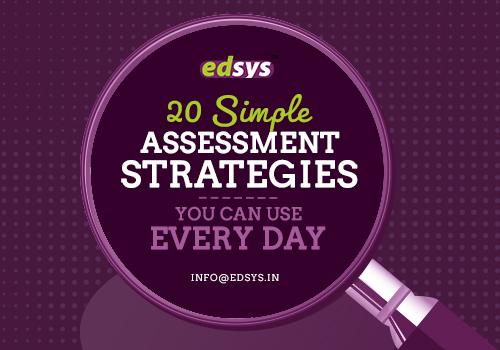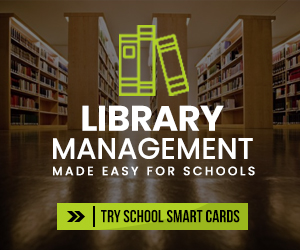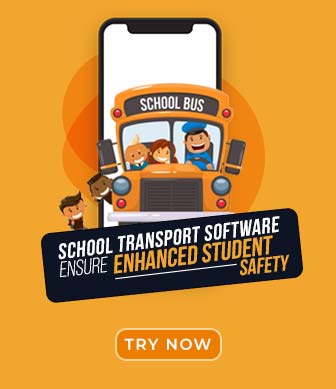Categories(658 Blogs)
Select Category
Watch Right Now
Teacher App - Class
Schedule & Attendance Management App
Parent App from Edsys

Best School Bus Tracking System

Cashless School - For Smart Schools of Tomorrow


20 Simple Assessment Strategies You Can Use Every Day

Daily assessment is indispensable for better molding of individuals.
Teaching is not only the art of covering the topics, but it is also about passing the knowledge to the students in real-time.
The assessment of individuals takes place only when the exams are done.
There isn’t always time to help the students to sort their weaknesses and misunderstandings after the tests have been graded. For that, we can depend upon a few assessment strategies to help students.
Here is a list of simple assessment strategies to use every day for teaching, planning and curriculum designing.
1. Come up with Open-Ended Questions
For an effective and better assessment of the students, always remember to ask open-ended questions.
Avoid “yes/no” type questions and phrases like “Do you like to read?”. Because students always tend to reply “yes” to the questions you ask.
Instead of “yes/no” questions, ask open-ended questions that will help children to improve their imagination skills and to develop ideas.
2) Ask Students to Reflect
During the last session of the class, the teacher can ask the students to explain what they have learned. It is one of the finest assessment strategies teachers can rely on.
The students can apply the concepts or ideas in such practical situations.
3) Use Quizzes
At the end of the class, students can be given a few quizzes for better understanding and to check comprehension. This helps teachers to evaluate their students.
4) Ask Students to Summarize
The teacher can challenge students to summarize daily topics briefly.
It helps them to review what they have learned.
5) Hand Signals
Students can incorporate hand signals as a measure to indicate an understanding of the content. They can show five fingers to indicate full understanding, three fingers for mild confusion and one finger to show they need help. This strategy helps to engage all the students and teachers can check for understanding within the large group.
6) Response Cards
Students can use index cards, magnetic boards, whiteboards, and other items to indicate their feedback to the questions asked by the teacher. This method helps the teacher to quickly assess the students.
Also Read: 15 Best School Bus Driving Games 2020
7) Four Corners
In this method, corners of the class can be used to indicate, “firmly agree”, “firmly disagree”, “agree somewhat” and “not sure”.
When the teacher asks a question, students can take any of the four corners to point out their opinion.
8) Think -Pair-Share
For the question asked by the teacher, the students can take a few minutes to think about the solution, then they can pair with a partner and share their ideas and present before the class.
9) Choral Reading
Students mark text for a particular theory or concept. They read the marked text in unison with the teacher. This method helps to improve reading and listening skills, differentiate between the reading of statements, dialogue, questions, etc.
10) One Question Quiz
As an assessment strategy, the teacher comes up with a single focused question allowing the students to answer within a few minutes either written or orally. The question should cover the main theme or concept of the daily lesson.
11) Socratic Seminar
A formal discussion based on the text, regarding a particular concept or idea. Students ask questions to each other and it continues with a series of discussions and responses. Within the context of discussions, the students share ideas and opinions.
12) 3-2-1
At the end of the class, the students consider and analyze what they have learned.
(3) What they understood,
(2) What they need to know more about and
(1) What are the questions or doubts they have?
13) Ticket Out the Door
Students note down the response for a specific prompt. The teacher collects the briefly written ideas at the end of the class and analyzes the responses of the students.
14) Journal Reflections
Reflections of each lesson can be summarized by the students. The places they need more help, the ideas conveyed, strategies they found helpful etc can be noted at the end of the class.
15) Formative Pencil–Paper Assessment
A short pencil- paper assessment is an easy way to monitor the things learned by the individuals. The teacher asks the students to self-correct. The teacher collects assessments and analyzes the results individually to examine student progress and also give instructions.
16) Misconception Check
Present before the students a common or predictable misconception relating to the topics they’ve covered. Ask to comment and explain the reason for agreeing or disagreeing.
17) Analogy Prompts
Making use of comparisons is a powerful tool. Periodically, give students an analogy prompt,” the idea being learned is like _____ because of _______”.
Also Read: Benefits and Features of Smart Card Management System
18) Practice Frequency
Always try to revise the topic or concept learned. It helps in better understanding least three times, minimum.
19) Use Variety
Teachers should make use of different individual and group techniques to check what students know. The same technique should not be repeated during a single class.
20) Peer Instruction
It is the most effective assessment strategies to analyze the understanding of individuals. Let the students explain to each other what they have learned. The method helps to improve leadership qualities, communication, etc.
Recent Blogs
Our Educational Services
Popular Blogs
Subscribe

SUBSCRIBE TO OUR NEWSLETTER
Sign Up and Recieve the Latest News
Don’t Worry, We Don’t SpamExplore Our Extensive Researched Educational App Directory
Visit Now
















